Updates |  |
2-20-09 Unveiling and chemistry 2-17-09 New Tots 9-19-09 Juiced sand |
Updates |  |
2-20-09 Unveiling and chemistry 2-17-09 New Tots 9-19-09 Juiced sand |
Video from GeekGroup experiments replicate some related features,, fulgurites.
Also see forum entry feb.2014, updated to include these developments.
Over a period of several days in spring of 2009, while responding to Michael's investigation, an effort got underway to determine how effectively an electric discharge can accomplish the formation of a particular common earthly crustal material, Granite, but more than that, how well, or under what conditions, an electric current passes through sand. Consideration of this question has probably been covered elsewhere but I'd like to include it here because it seems important in an overall understanding of earth's history and other considerations which involve other rock material. What seems to have been accomplished, in this recent experiment, with the use of an electric current through a sand in solution is an alteration of material, in this case sand, with a change to its granular characteristics but mostly a dramatic change to its color. I know sand can be heated and melted to make glass, and from the recent experiments it appears that the granular structure of sand can be altered slightly and fused by running a current through the sand in solution. Sand does not seem to be a good conductor of electricity so the need for an 'in-solution' exposure is the way chosen to saddle this horse. Might this be a fulgamite. I'm inclined to think that granite's igneous identity seems hard to swallow from the perspective of a molten material origin, I just can't imagine how the grains remained individualized. I'm sure someone can expand my imagination, if that process is valid. If it is not then this discussion should prove valuable in proceeding with further experiments on; "is it arc formed or by some other electrically related process".

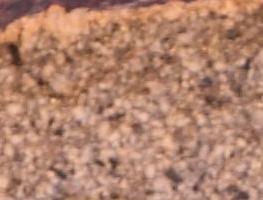
In this image you are looking at the side view of a button shaped conglomorate. One side had direct contact with the probe. This was formed in a metal fence-cap so current was probably going off to the side of the container,staying rather flat as opposed to going vertically through the depth of material. Adjacent image is of local granite.
Several links to the individual images are below.
These samples don't look anything like the original material shown in the first image. In the first sample there is more white crystal combined or gathered in what looks like a layer. Since i used sea salt to create a conductive environment i'm suspicious that the salt may have reconstituted as the water was boiled away under the heat of the current flow, the highest setting on my 120 volt wire/feed welder. Lots of gassing occurred during the process and i kept adding the salt water solution when the sample stopped giving signs of conducting current.
I don't know what to think about these results except that i was surprised at the separation of a material, a brownish very fine material, that crusted at the surface of the ground probe.
I'm still pondering what has occurred overall with this process of running a somewhat high current through this sand saturated with salt water. The samples feel and sound quite hard packed but is brittle.
I just don't know what to think but here are some details that have stood out which could make for a clearer picture for those of you in the know.
raw sand
sample 1
flipped 180
half a pair
twins2
twins
contrast
compactable
3rd run
Unveiling
Dark tots
Dark comparison
New tots 1
New tots 2
During the initial phase of the passage of current through salt water in a
plastic cap a greenish color was seen at the ground electrode. In later runs the
vapors given off were quite irritating if breathed and while doing another phase,
with an arc, a bystander commented on a greening color to the flame. I found a
reference to the constitutants of salt being individually quite toxic so this may
explain some of this. See the expanded details of this
update note for more info. There was also a yellow but i need to re-run that phase because there was a lot happening as the water fizzed, bubbled, smoked and gassed. Sand was added to that mix and the most notable detail was the brown material which collected at the ground electrode. I suspect these were organic materials being boiled out of solution but that is just a guess. No pictures were taken of this so i'll do it again for that purpose too.
The next setup which produced the sample shown above, #1, involved a galvanized fence cap as the crucible. The ground electrode of the DC welder was on the cap and the head of a large bolt was used to make contact with the solution. The plating of these two items is a significant detail going through my mind because it appeared to degrade on both. For sure, the galvanized coating came off the inside of the cap, this probably made its way into the some part of the final sample. The brown color seen in the first run looks to have permanately discolored the sand around the edge of the sample and that which was underneath, that sand fell apart easily and some was not bound together at all.
 | This permanent re-coloring could give a clue to Sedona sandstone
and other types such as monument valley's material. |
| An additional thought 2010 The granulation and coloration is also similar to several rock formations in the Phoenix Az region. It is called Papago Buttes, just outside Scottsdale. Hole in the rock is one notable feature but many notches exist there. I'd classifiy this formation as very unusual in its placement and the absence of similar formations. You must look at the following link and the explanation for this rock formation. Meteor Strike in 1680 | |
 Ones on right are 30hrs old Note that the color is holding |
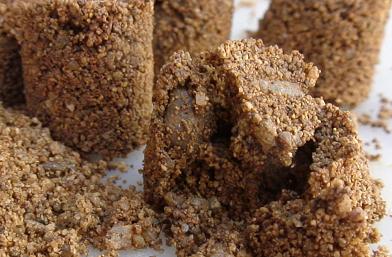 Update to ones on right(1-30-09), they are now several days older. |
| Following a washing of the sand of only the pile on the right it has retain discoloration. Another washed sample is in the process of drying. (2-05-09) | 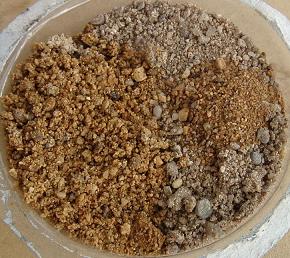 |
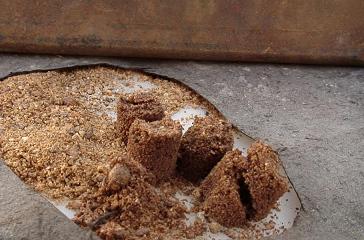 After many more days the sand tots have darkened. |
 Comparing the color of three stages: original in middle, spread and dried on the right and the aged tots upper left all naturally air dried. |
While running the setup I kept adding the salt water which was in the bath surrounding the cap. Due to the boiling of the sand i had to push the sand material back into the cap and after a while it no longer boiled loose. There was arcing to the solution and this seemed to be the primary source of the boiling. It would raise the sand around the bolt head and i could've pushed it deep into the sand but instead of that i kept it on the top of the material being repositioned, from the rim of the crater being formed, to the center of the cap. I also pressed down on the material to keep good contact but as the solution boiled away the obvious signs of current flow ceased so just enough salt water was added to keep either a vapor coming off or the sound of current flow. If i put too much fluid on the surface the activity would loosen the surface in the early portion of the run, later on in the run i was holding back on getting to much saturation.
Other than possibly zapping myself and the toxicity of the material use to galvanize this fence cap, i have no idea of other hazards so any words of caution would be appreciated. Like wise, i know little of the chemistry of the salt or the water other than some very basic details one being that hydrogen gas is separated from h2O when an electric current is passed through it. Another is that salt comes out of solution as it is evaporated, but how it behaves while being zapped and boiled in the presence unwashed sand and metal plating is beyond my knowledge, at this stage.
I mentioned earlier that during the run which just involved the salt water, actually iodized sea salt and rain water(which had been in a sealed jug and not showing significant signs of growth), there were two colors appearing in the water, first a yellow and then a green. These came off the ground probe which was a metal rod with some type of plating on it. I've seen a yellow residue while welding or heating galvanized metal so this may explain the yellow discoloring of the water around the electrode. As for the green color, that is a mystery. I've seen it with copper wire but that material was not obviously present. The water then turned a darker color sort of blackish. Again, i can only guess what was happening chemically and that would not be an educated guess.
The run that produced sample two, the twins, was done in much the same manner as the previous with only a change to the crucible, it was a metal funnel from my cheap capachino machine. It too, lost its plating on the interior. I ran this setup a bit longer and when the salt water was all gone i used rain water with some slight signs of algee formation. The same bolt was used and the same polarity was used. I may have over done the duration, if the sample turning blackish is any indication. A greater thinckness was acheived in this run but the sand below the surface obtained the same brown discoloration and did not become caked. I suspect that this was again due to the metal container and current passing across the surface rather than through to the bottom of the sample. The next run has already begun with a container of cardboard with a metal bottom, a frozen OJ container. The results seem to be showing a column of altered material coming up in the center where the electrode rested.

|
After two week of open air exposure. |
The unveiling has occurred

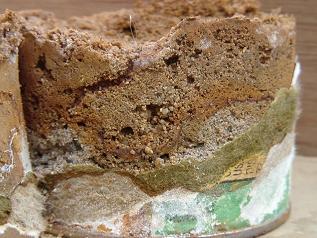
 |
Update Sept.2009
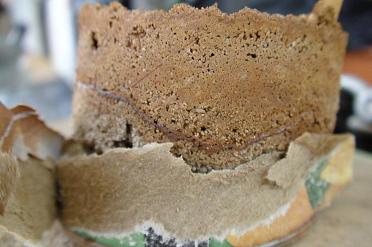 After six months |
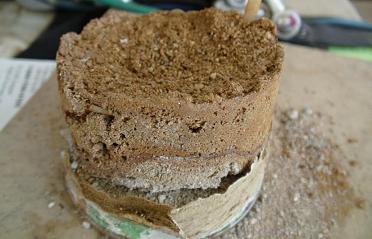 degradation is minor |
You will want to look at the larger images of these so you can see some features that strike me as rather odd.
Update May 2016 Full scale examples from Afghanistan movie.
The similarity between this geologic example and what was created in the juiced salty-sand experiment is quite amazing. Can we propose that these geologic areas were saturated or submerged and carrying/exposed-to very large electrical currents before they became the barren waste-lands of today?
| A detail of interest is the dip at the surface matched by a dip at the boudary layer 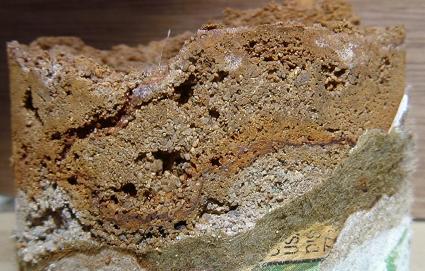 |
Note the shiny beads at lower center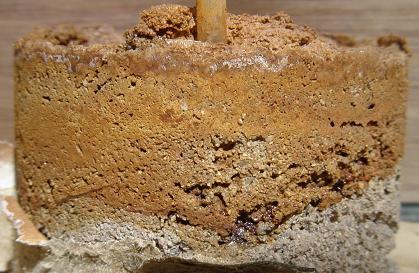 |
Chemistry Update Details
By the way for you real backyard experimenters out there, the discolored sand of run #2 tastes terrible of salt and who knows what else. The white material of the top photo, what little i could get, seemed a bit salty. And i haven't yet examined the grey material of the last run. I'm relatively sure i've got nine lives, and certain of God's protection in my life.
Well maybe 8 now, here is what a book called Earth Science (by Tarbuck/Lutgens) had as a note on the subject of salt and chemistry. "An example of chemical bonding involving sodium (Na) and Chlorine (Cl) is the compound sodium chloride (NaCl, common table salt). When the sodium atom loses one electron it becomes a positive ion, and when the chlorine atom gains one electron it becomes and negative ion. These opposing charges act as a bond, holding the atoms together. Here it is interesting to note that chlorine is a green, POISONOUS gas and sodium is a silvery metal, which, if held in your hand, would give a severe chemical burn. Together, however, these atoms produce the compound sodium chloride, which looks nothing like either and is a requirement for human life."
I guess no one read my note asking for a heads up about any dangers. On the other hand i may not be breaking the chemical bond by the electric current or the extreme heat. Based on a few details i'd say i was, because of the silvery characteristics of the sand in the last image, the green coloration observations, the irrative nature of the vapors comming off the electricaly boiled sand, and the irritation to my tongue when I tasted for the presence of salt.
Now in light of this, and surviving (by the grace of God) my lack of educators,
there may be something hinted to by this which might apply to the historical
reconstruction which all this effort is intended to complement. We have in
numerous location discolored sand and sandstone of a redish color, we also have
the mentioning of catastrophic electrical events that caused the loss of life in
some locations while in others, namely where these red sandstones are located,
there is a mystery of the sudden departure of people, might there be a connection
with electrical interaction with bodies of saltwater and sediments in the vacinity
of these occurrances? Just a side note, but one that i'd investigate if i had a
few more clues to make this notion more inticing.
New Tots, Just sand and Salt (no electric current)
All the whitish looking tots in the images above were made with the same
salt and rain water as the earlier tots. That was 48 hours ago as of the 17th.
They took on an expected whitish appearance since the water evaporated and left
behind the disolved salts which were in solution, but here is what make this so interesting, the absence of electric current passing through the salt/sand solution has already left the sand colored dramatically different than those samples pictured earlier on this page. Remember that the earlier samples took a long time to dry out, and that was after having the water boiled away by the electric current. Several days passed by and then the earlier samples started to get darker in tint. If this does not happen with these new samples, turning rust color, then this could be stronger evidence for the involvement of electrical activity in the formation of certain sandstones of this same color characteristic, the rusty look.
Your input is welcomed.